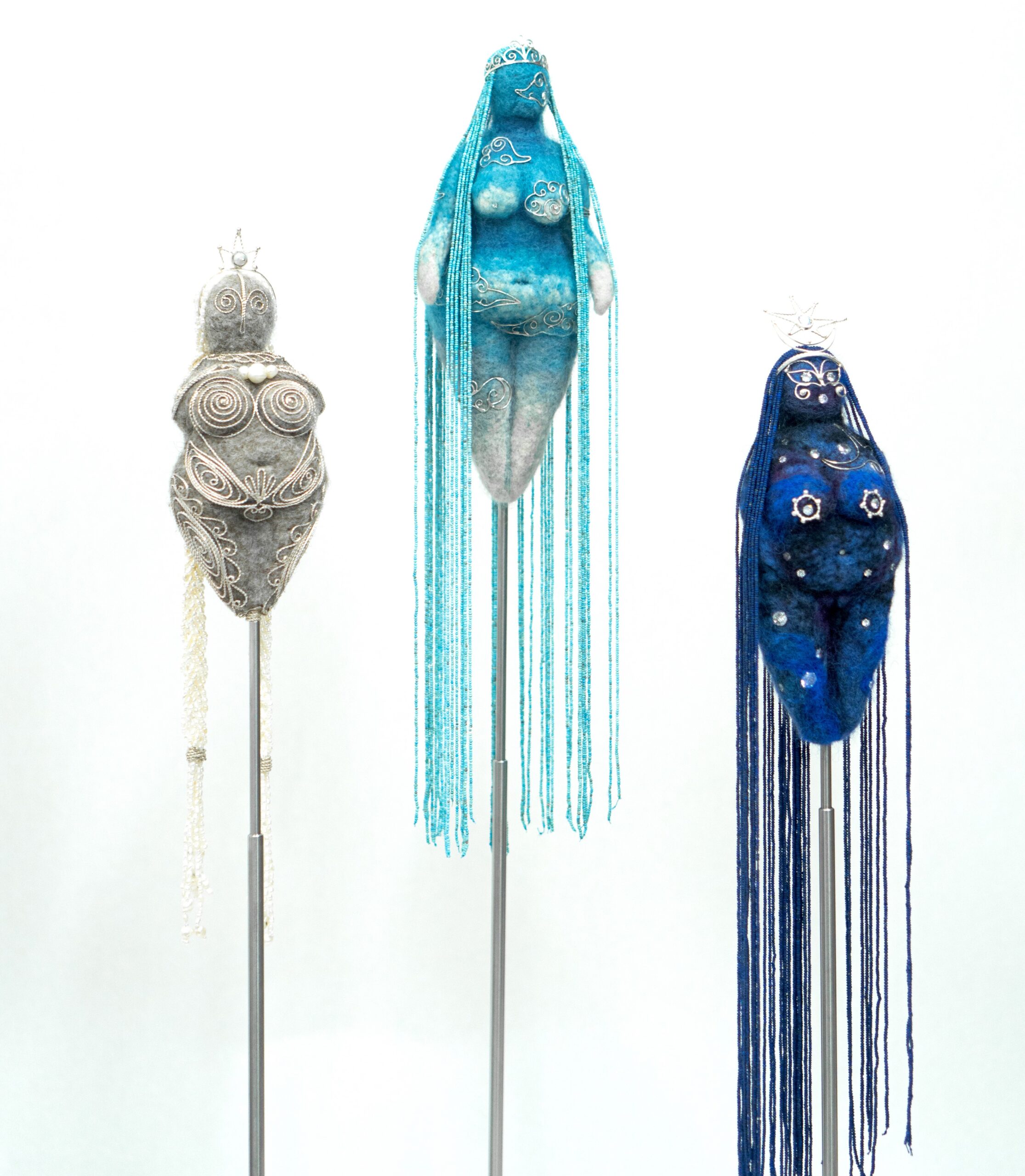
In the heart of Tribeca in New York, the Sapar Contemporary Art Gallery has launched a new exhibition, Beneath the Earth and Above the Clouds, which brings Central Asian narratives to the forefront.
This dual show – which runs until May 15, 2025 – features Altynai Osmo and Aya Shalkar, two artists who have been devoted to exploring female narratives in the region, and do this through works that are both steeped into tradition, and modern and vibrant at the same time.
The Times of Central Asia spoke with Altynai Osmo, a multimedia artist from Kyrgyzstan whose work weaves the threads of nomadic heritage with contemporary expression.
Born in Bishkek and nurtured by the serene shores of Lake Issyk-Kul, Osmo’s artistic journey is deeply rooted in the traditions of her homeland. A graduate of Central Saint Martins in London, she seamlessly blends mediums — textiles, metals, video, and installation — to explore themes of identity, matriarchy, and the evolving role of women in Central Asian societies.
Her works such as Blessing Yurt, a red fringed costume inspired by the Kyrgyz nomadic traditional dwelling, not only pay homage to ancestral practices but also challenges present-day socio-political narratives.
Speaking with TCA, Osmo reflects on the layers of meaning in her new series, her enduring engagement with mythology and matriarchy, and how her practice bridges personal memory and collective history.

Image courtesy of Altynai Osmo/Sapar Contemporary Art Gallery
TCA: Can you tell me about how your previous practice led to this new series for the show?
My previous work has always involved exploring the intersections of feminine identity, cultural memory, and inherited spirituality in Central Asia, particularly in Kyrgyzstan. This new series evolved naturally from that foundation. It reflects a more layered and intentional engagement with Central Asian history, mythology and matriarchal histories — particularly the symbolic and spiritual dimensions that have often been erased, distorted and forgotten.
The materials and narratives I use now draw more explicitly from the Kyrgyz epic, Manas, ancestral craftsmanship, and belief systems like Tengrism, allowing me to express deeper reflections on women’s roles across time.
TCA: Your Kyrk Kyz series reinterprets the legendary warrior women of Central Asia. How does this mythology resonate with contemporary Kyrgyz identity and gender roles?
The Kyrk Kyz legend, with its origin in female strength and collective action, presents a striking contrast to the more patriarchal norms that dominate present-day Kyrgyz/Central Asian society. Revisiting these stories reminds us that women were once seen as the protectors of land, lineage, and cultural continuity. By reimagining these warriors through my art, I want to challenge modern gender expectations and inspire a reconnection to a more empowering view of womanhood that is already rooted in our collective past.

Image courtesy of Altynai Osmo/Sapar Contemporary Art Gallery
TCA: The use of felt in your masks ties your work to nomadic traditions. How does the choice of materials reinforce the themes of your work?
Felt is not just a material; it’s a carrier of memory and tradition. It’s historically linked to the lives of Kyrgyz nomadic women who created everything from boz ui — yurt covers — to shyrdak carpets, clothing, and saddlecloths. By working with felt, shyryk stitch embroidery, and meaningful oimo symbols found in heirloom shyrdaks, I’m paying homage to women’s labor and artistry while embedding stories of female resilience into the physical structure of my work. These materials allow me to bridge generations and honor women as masters, creators, and custodians of both culture and meaning.
TCA: The etymological link between “Kyrgyz” and “Kyrk Kyz” is intriguing. How do you see this linguistic history shaping national and cultural narratives?
This link is powerful; it positions women not just as participants in national history, but as its origin. By reviving the interpretation of Kyrgyz as Kyrk Kyz — “Forty Girls” — I hope to shift how we understand our nation’s beginnings. It encourages us to recognize matriarchal roots in our heritage and to reclaim stories that validate women as leaders, warriors, and originators, rather than passive figures shaped by male dominance.

Image courtesy of Altynai Osmo/Sapar Contemporary Art Gallery
TCA: Your depiction of Umai Ene connects fertility, motherhood, and protection. How does this figure challenge or affirm modern perceptions of womanhood in Central Asia?
Umai is a goddess of Earth and fertility in Tengrism. Rather than framing women solely through the lens of domesticity, she embodies sacred power — nurturer, protector, and cosmic force. In today’s context, this depiction is both affirming and confrontational. It validates roles traditionally assigned to women, like caregiving, but it elevates them to a divine status, demanding they be seen as sources of life and strength, not servitude or limitation.
TCA: Tengrism plays a role in your work. How do you balance spiritual heritage with contemporary artistic expression?
Tengrism offers a philosophical and spiritual foundation that I interpret through a contemporary lens. I’m not trying to recreate the past, but to bring ancient wisdom into dialogue with the present. This balance allows me to address both personal and societal aspects, reflecting the inner search for meaning alongside the collective need for harmony, equilibrium, and respect for nature and feminine energy. I try to express this through modern techniques, mixed media, and symbolic juxtapositions.

Image courtesy of Altynai Osmo/Sapar Contemporary Art Gallery
TCA: Your artworks explore dualities — earthly vs. divine, tradition vs. transformation. How do you navigate these contrasts in your creative process?
Rather than seeing these as binaries, I see them as layered realms that constantly inform one another. In my work, the earthly is divine, and tradition holds the seeds of transformation. I navigate these through symbolic layering — mixing ancient techniques with modern forms, myth with lived experience, feminine forms with cosmic symbols. This tension creates space for complexity and fluidity, reflecting how identity, especially female identity, cannot be confined to one plane or time.
TCA: Central Asian histories are often male-dominated. What does reclaiming female figures through your art mean to you?
By reclaiming figures, I’m not inventing new stories, I’m restoring often forgotten and overlooked ones. It’s about celebrating and honoring women, equity, and visibility. It’s an act of cultural repair, giving voice to the silenced and reviving ancestral memory. This reclamation also becomes deeply personal; it affirms my own presence and that of countless other women in cultural spaces where we’ve historically been pushed to be invisible.
In our Central Asian patriarchal society, and particularly in nomadic cultures, there is a longstanding tradition of remembering the names of seven fathers — a way of honoring our male ancestors. I have always questioned why there is no similar recognition and celebration of our female ancestors. In my art, it is deeply important for me to equally honor, remember, and celebrate our female ancestors — the foremothers who have profoundly shaped the world we live in today.

Image courtesy of Altynai Osmo/Sapar Contemporary Art Gallery
TCA: How does the political and cultural landscape of Kyrgyzstan influence your engagement with historical and spiritual themes?
The current cultural climate in Kyrgyzstan is marked by growing conservatism, gender inequality, and rising violence against women. In such a context, personally for me, exploring female-centered history and spirituality becomes an act of defiance. It’s not just art — it’s a form of resistance against the erasure of progressive, inclusive narratives. My work is shaped by this tension; it calls for reflection and reclamation at a time when women’s freedoms and rights are increasingly under threat.
TCA: Your work suggests that mythology still holds power today. Do you see it as a tool for activism?
Absolutely. Mythology is almost like a powerful cultural script. When we revisit these myths and reframe them through a feminist lens, we expose new possibilities for identity and belonging. Myth becomes a tool for reimagining the future by reconnecting to empowering pasts. It invites people to question dominant narratives and to find strength in stories that reflect their truth.

Image courtesy of Altynai Osmo/Sapar Contemporary Art Gallery
TCA: What role does personal memory play in your reconstructions of cultural history?
Personal memory is the thread that connects me to collective memory. My childhood, the upbringing and stories of my mother and grandmothers passed down through oral traditions, the indigenous Kyrgyz rituals embedded in everyday life, and the ordinary yet extraordinary women I’ve encountered — all inform how I interpret historical and spiritual symbols and narratives.
My great-grandmother Shakil, grandmothers Koken and Selkin, Nancy, Anne, and my mother Dinara have each played a deeply personal role in shaping my worldview — one that I continually explore and reconstruct through creative expression. By weaving personal memory into mythic and cultural histories, I make them intimate and alive, grounding collective pasts in emotional, lived experience.
TCA: Has engaging with your audience — locally or internationally — shifted your perspective on the themes you explore?
Definitely. International audiences often find universal resonance in these themes of reclaiming suppressed identities, of women reconnecting with power, of spiritual grounding. Meanwhile, local engagement reminds me of the urgency of this work, how vital it is for Kyrgyz women and communities to see their heritage reflected with pride and depth. These interactions constantly reshape my perspective and push my work in new directions.
TCA: What future projects are you working on that continue your exploration of myth and identity?
I have several ideas and projects ahead, but the one I’m most focused on is the research I’m conducting on the Kyrgyz epic of Manas. This is the most significant project I’m preparing to delve into in my art for the years to come. It’s about deepening my exploration of the symbolic spaces where history, myth, ecology, and cultural identity converge, continuing the journey of uncovering what is at risk of being forgotten.

Image courtesy of Altynai Osmo/Sapar Contemporary Art Gallery
Beneath the Earth and Above the Clouds, featuring the work of Altynai Osmo and Aya Shalkar, will be on display at the Sapar Contemporary Art Gallery New York until May 15, 2025.
